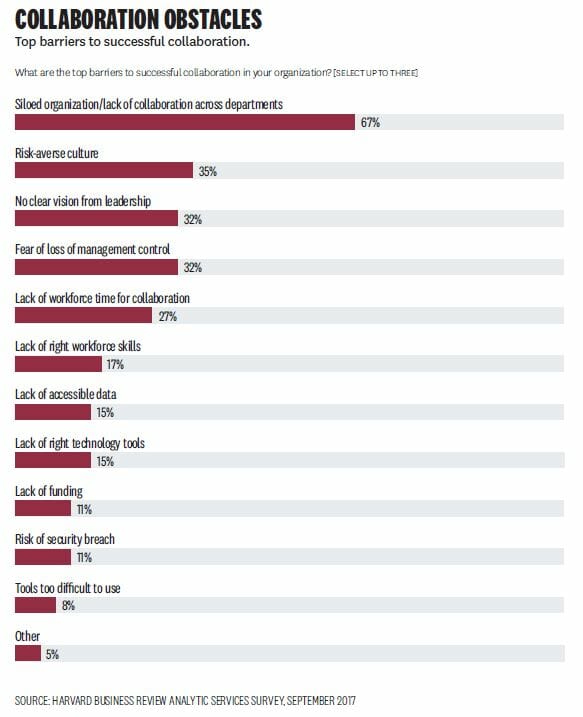Leaders expect people to collaborate. But collaboration doesn’t happen alone. The illusion of cooperation can turn collaboration into a trap.
Collaboration is critical to thriving in an ever-changing environment — it helps organizations solve complex problems in less time by bringing together various experts, accelerating go-to-market time, and responding more rapidly to fast-changing environments.
Failing to practice collaboration can put your organization behind your competition in a fast-paced 21st century. Research shows that 81% of people believe collaboration is critical and 71% think their managers are making it a priority.
So, why do so many companies still fail to collaborate?
Senior executives have an unrealistic vision of collaboration. They assume their direct reports are aligned with the strategic vision. Or have an idealized — conflict-free — image of what a highly collaborative team should look like. Pushing people to work together doesn’t work.
True collaboration cannot be imposed — it must be designed and facilitated. 
That’s the first thing I tell my clients. CEOs are frustrated with how their teams collaborate, but their approach is not helping — it actually backfires. They assume collaboration is a given. Most executives believe that building a high-performing team requires picking all-star people and letting them figure things out.
Research by Heidi Gardner, author of Smart Collaboration, demonstrated that merely putting a team of experts or specialists on the same project is not enough — leaders must create the right conditions.
The Harvard Business Review research found — no surprise — that organizational silos are the key obstacle to successful collaboration. However, those silos are the result of people’s mindset and behavior. Culture, leadership, fear of control, and lack of time inhibit successful collaboration.
Collaboration is a byproduct of culture; it requires the right conditions, mindset, and tools.
Here’s how to avoid falling into the nine most frequent collaboration traps.
Avoid the collaboration burnout
Always-on cultures, demanding bosses, collaborating with a decentralized workforce spread across different time zones, and inefficient use of technology are draining people.
Tech tools like collaboration platforms have increased team communication and productivity. But overuse and inefficient practices create a collaboration overload.
Also, new research has uncovered another reason: Much collaborative overload is driven by people’s desire to maintain a reputation as helpful; by trying to over-collaborate, they find themselves at a breaking point.
When clients hire me to help their teams adopt new behaviors, the first I tell them is, “What are you going to get rid of? New practices should replace old ones, not add more burden to your team.”
The collaboration burnout drains teams. People are busy jumping from one thing to another at the expense of having less time for deep work, effective decision making, and to build strong relationships with other team members.
Your team doesn’t have an infinite capacity — collaboration is time and energy consuming. If you ask people to engage in a new collaborative project, give them space to get rid of other tasks.
Stop idealizing collaboration
Many people naively see collaboration as a friendly approach style in which relationships matter more than the task at hand. Cooperation is not about consensus or getting along with others, though those are nice-to-have.
Effective collaboration should focus on the outcome, not on making friends. Tensions keep your team at their top of the game. Constructive conflict-management requires integrating opposing ideas and personalities, not to neutralize differences.
Collaboration is a means to an end — what the team delivers matters more than how they work. Some groups are very friendly but are not effective.
Also, avoid portraying collaboration as a magical solution for all organizational problems. The more managers focus on selling the upside, people focus on what they might lose. People see things from their own reality, not yours.
Collaboration is uncomfortable, more times than not. People must get used to working with people outside their team, to interact with folks they might not like or that work in other locations with the addition of time zones, technology, and language barriers.
Portray collaboration in a more realistic, human way. Idealizing it will only backfire.
Collaboration is a byproduct of culture
Kicking off a new team requires building trust and understanding. People will resist, conflicts will arise. The emotional culture always gets in the way. It cannot be suppressed.
Leaders must work to build a culture for collaboration; they must provide a safe space.
As Jacob Morgan, head of The Future Organization, said, “Collaboration can only exist in an environment where people feel safe. If you don’t have an organization where people feel the ability to be vulnerable, to be empathetic, to be themselves, then you are not going to have collaboration.”
Power is also a cultural thing that needs to be addressed openly. When leaders don’t want to give up their power, you can’t expect the “regular folks” to give up theirs. People need to be clear about the rules of engagement and how the team will make decisions.
Wise leaders are generous; they enable people to do great things, rather than provide the solution themselves — great CEOs act like a coach more than a general.
To develop a collaborative mindset requires training people to open up about their fears, resistance, and objections. That requires ongoing conversations, not just a one-off meeting.
Don’t take alignment for granted
Visionary leadership can blind executive — they are so excited about their vision and assume everyone is on board.
As this HBR piece explains, the emphasis on visionary leadership relies on the assumption that managers outside the C-suite are always aligned with corporate strategy. But, what if they are not?
Middle managers play a key role in change initiatives — they are tasked to align their teams around a new strategy. CEOs take for granted that, because of their positions, middle managers are convinced about the new direction by default.
Driving alignment is not about persuasion but an act of co-creation. Rather than selling your perfect vision, involve your middle managers at an early stage. Allow them, not only to provide feedback but also to share ideas and shape your vision.
The days when the C-suite revealed a visionary approach and the rest had to buy into it are gone — if that approach ever worked. Collaboration cannot be imposed; it happens from within ; it’s a personal choice.
Your team must be involved in not only driving but also designing change. Collaboration is not about selling something that’s already been baked but inviting them to cook it as well.
Groups don’t want to sacrifice their identity
In mandating and driving collaboration initiatives, leaders tend to focus on outcomes, processes, and logistic. However, they forget to consider how the groups interpret that request. Lisa Kwan calls this the collaboration blind spot.
Each team has a culture of its own. When managers ask them to break down barriers, share information or resources, people feel threatened .Tthey worry about how this might affect their identity.
As Kwan explains, groups define and develop their sense of security along three main dimensions: identity, legitimacy, and control.
- Group identity is what a group understands itself to be — its purpose.
- Group legitimacy means that a team is perceived as valuable. Outsiders value its contribution.
- Control implies that the group determines how it operates and implements change.
Respect each group’s identity. Not doing so can make people retreat into themselves and assume a defensive posture . They will become siloed instead of collaborative.
To engage in effective cross-group collaboration, teams might feel safe and protected. It’s better to start small than to expect groups to share all their secrets and resources instantly.
Collaboration must be purpose-driven
One of the reasons cross-team collaboration fail is that it’s not perceived as meaningful. Most leaders focus on the goals and why an initiative makes sense from an organizational and business standpoint but fail to connect it with something deeper.
A team purpose is always more meaningful and relevant than a corporate one. When launching a new initiative, leaders must address the “What’s in it for me?”
A collaboration purpose answers the “Why are we supposed to work together?” question. Not just what the team must achieve by working together — the deliverables — but the impact their work will create both on them and the organization.
Our values and beliefs are supposed to bring us together, yet sometimes tear us apart, as I wrote here. Leaders must create a common ground. Focusing on a shared purpose will drive the team toward what everyone is trying to achieve collectively.
Involve the different groups and let them craft the collaboration purpose. Also, they should define expectations, rules of engagement, and how each ‘side’ will contribute. Team rituals are an effective way to design and kick off a cross-functional team.
Collaboration doesn’t mean erasing sides but integrating them.
Reward the team, not individuals
Conflicting rules send conflicting messages.
Though most organizations encourage collaboration — a collective practice — their reward system is based on individual or specific performance. How can you expect the different areas to work together when sales, marketing, and customer service are measured by conflicting metrics?
The same happens with performance reviews, bonuses, and promotions , they encourage people to focus on what’s best for each person not for the overall team.
Also, always-changing or contradictory messages confuse teams. Clarity and consistency are key to push a team in one direction.
If you reward individual behaviors, don’t expect people to pursue goals collectively.
∼∼∼∼∼
But don’t neglect individual performance. See “The Serious Consequences of Getting Team Recognition Wrong”
∼∼∼∼∼
Technology doesn’t solve people problems
Most managers now spend 85% or more of their work time collaborating via e-mail, meetings, group messaging platforms or on the phone, an increase of 50% over the past decade.
The digital revolution has accelerated the ability to engage with other people. However, there’s a difference between interacting with other people and effective collaboration: it’s the outcome, not the time spent, what matters.
Technology facilitates collaboration but doesn’t encourage it. Having the right tools is essential to accelerate cooperation, but if organizations don’t fix the people problems discussed above, technology won’t be useful enough.
Lastly, organizations must train their employees on how to use technology more mindfully. Today, many people are suffering from burnout . They need a digital detox, not more tech.
Collaboration is not just H2H
Collaboration is intrinsically a human function, but not limited to people.
Technology will continue to play a bigger role in the future of collaboration. The rapid growth of AI will change not only what people do but also shape our way of working.
Organizations must prepare their teams not just to become better at cooperating with other people, but also to collaborate with technology.
As David Coleman, author of 42 Rules for Successful Collaboration said, “We’re moving into an era where collaboration is not just human-to-human but human-to-machine collaboration and machine-to-machine collaboration.”
Collaboration is a way of working. It attracts and brings together people outside the regular structure, practices, and expertise to accomplish a complex shared goal. But it’s far from being smooth or conflict-free.
A human-centered approach can help avoid the collaboration trap. It requires understanding the challenges through people’s eyes. To develop a culture that is safe for teams to let go of being defensive and work together in achieving something more meaningful.
Human beings are collaborative by nature but don’t collaborate by default . It’s up to you to create the right conditions for successful cooperation.
